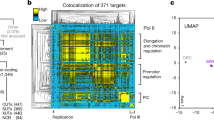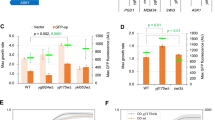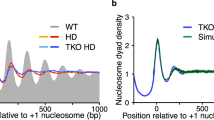Abstract
Before transcription can begin, the chromatin structure must be rearranged at the nucleosome level. In yeast the nucleosome remodeling complex RSC is involved in this process and it is essential for growth. Recent analysis of the RSC by mass spectrometry has suggested that the product of YLR033w, an essential gene of unknown function, is a novel component of the complex, and the gene has been renamed RSC58. Rsc58 is predicted to be 502 amino acids long. We have isolated five temperature-sensitive mutations in RSC58 and studied the cellular function of the gene. Our major findings are the following. (1) Two of the alleles have a frameshift mutation near the 3′ end of the gene, in codons 482 and 485, respectively. The first mutation is associated with the more severe phenotype. This is compatible with the finding that removal of the C-terminal 25 residues of Rsc58 is lethal to cells. These results suggest that C-terminal region is essential for Rsc58 function. (2) RSC4, which codes for another member of the RSC, was found to be a multicopy suppressor of the phenotype of one of the temperature-sensitive mutants. (3) Two-hybrid analysis identified Swi6, a transcription factor, as a candidate interactor with Rsc58. An interaction between Rsc58 and Swi6 is also suggested by the fact that rsc58-ts Δswi6 double mutants show a more severe growth defect than either mutation alone. These results suggest the possibility that Rsc58 mediates between nucleosome remodeling and the initiation of transcription.










Similar content being viewed by others
References
Andrews BJ, Moore LA (1992) Interaction of the yeast Swi4 and Swi6 cell cycle regulatory proteins in vitro. Proc Natl Acad Sci USA 89:11852–11856
Angus-Hill ML, Schlichter A, Roberts D, Erdjument-Bromage H, Tempst P, Cairns BR (2001) A Rsc3/Rsc30 zinc cluster dimer reveals novel roles for the chromatin remodeler RSC in gene expression and cell cycle control. Mol Cell 7:741–751
Burke D, Dawson D, Stearns T (2000) Methods in yeast genetics: a laboratory course manual. Cold Spring Harbor Laboratory Press, Cold Spring Harbor, N.Y.
Cairns BR., Lorch Y, Li Y, Zhang M, Lacomis L, Erdjument-Bromage H, Tempst P, Du J, Laurent B, Kornberg RD (1996) RSC, an essential, abundant chromatin-remodeling complex. Cell 87:1249–1260
Cairns BR, Erdjument-Bromage H, Tempst P, Winston F, Kornberg RD (1998) Two actin-related proteins are shared functional components of the chromatin-remodeling complexes RSC and SWI/SNF. Mol Cell 2:639–651
Cao Y, Cairns BR, Kornberg RD, Laurent BC (1997) Sfh1p, a component of a novel chromatin-remodeling complex, is required for cell cycle progression. Mol Cell Biol 17:3323–3334
Chai B, Hsu J, Du J, Laurent BC (2002) Yeast RSC function is required for organization of the cellular cytoskeleton via an alternative PKC1 pathway. Genetics 161:575–584
Cosma MP, Tanaka T, Nasmyth K (1999) Ordered recruitment of transcription and chromatin remodeling factors to a cell cycle- and developmentally regulated promoter. Cell 97:299–311
Cosma MP, Panizza S, Nsamyth K (2001) Cdk1 triggers association of RNA polymerase to cell cycle promoters only after recruitment of the Mediator by SBF. Mol Cell 7:1213–1220
Damelin M, Simon I, Moy TI, Wilson B, Komili S, Tempst P, Roth FP, Young RA, Cairns BR, Silver PA (2002) The genome-wide localization of Rsc9, a component of the RSC chromatin-remodeling complex, changes in response to stress. Mol Cell 9:563–573
Du J, Nasir I, Benton BK, Kladde MP, Laurent BC (1998) Sth1p, a Saccharomyces cerevisiae Snf2p/Swi2p homolog, is an essential ATPase in RSC and differs from Snf/Swi in its interactions with histones and chromatin-associated proteins. Genetics 150:987–1005
Graham TR, Emr SD (1991) Compartmental organization of Golgi-specific protein modification and vacuolar protein sorting events defined in a yeast sec18 (NSF) mutant. J Cell Biol 114:207–218
Hsieh Y, Kundu TK, Wang Z, Kovelman R, Roeder RG (1999) The TFIIIC90 subunit of TFIIIC interacts with multiple components of the RNA polymerase III machinery and contains a histone-specific acetyltransferase activity. Mol Cell Biol 19:7697–7704
Hoffman GA, Garrison TR, Dohlman HG (2002) Analysis of RGS proteins in Saccharomyces cerevisiae. Methods Enzymol 344:617–631
Ito T (2003) Nucleosome assembly and remodeling. Curr Top Microbiol Immunol 274:1–22
James P, Halladay J, Craig EA (1996) Genomic libraries and a host strain designed for highly efficient two-hybrid selection in yeast. Genetics 144:1425–1436
Kingston RE, Narlinkar GJ (1999) ATP-dependent remodeling and acetylation as regulators of chromatin fluidity. Genes Dev 13:2339–2352
Koch C, Nasmyth K (1994) Cell cycle regulated transcription in yeast. Curr Opin Cell Biol 6:451–459
Koch C, Moll T, Neuberg M, Ahorn H, Nasmyth K (1993) A role for the transcription factors Mbp1 and Swi4 in progression from G1 to S phase. Science 261:1551–1557
Koyama H, Itoh M, Myahara K, Tsuchiya E (2002) Abundance of the RSC nucleosome-remodeling complex is important for the cells to tolerate DNA damage in Saccharomyces cerevisiae. FEBS Lett 531:215–221
Laurent BC, Yang X, Carlson M (1992) An essential Saccharomyces cerevisiae gene homologous to SNF2 encodes a helicase-related protein in a new family. Mol Cell Biol 12:1893–1902
Macpherson N, Measday V, Moore L, Andrews B (2000) A yeast taf17 mutant requires the Swi6 transcriptional activator for viability and shows defects in cell cycle-regulated transcription. Genetics 154:1561–1576
Morera JM, Holmberg S (1999) Transcriptional repression of the yeast CHA1 gene requires the chromatin-remodeling complex RSC. EMBO J 18:2836–2844
Ng HH, Robert F, Young RA, Struhl K (2002) Genome-wide location and regulated recruitment of the RSC nucleosome-remodeling complex. Genes Dev 16:806–819
Ohkuni K, Okuda A, Kikuchi A (2003) Yeast Nap1-binding protein Nbp1 is required for mitotic growth at high temperatures and for cell wall integrity. Genetics 165:517–529
Peterson CL, Workman JL (2000) Promoter targeting and chromatin remodeling by the SWI/SNF complex. Curr Opin Genet Dev 10:187–92
Peterson CL, Zhao Y, Chait BT (1998) Subunits of the yeast SWI/SNF complex are members of the actin-related protein (ARP) family. J Biol Chem 273:23641–23644
Sanders SL, Jennings J, Canutescu A, Lind AJ, Weil PA (2002) Proteomics of the eukaryotic transcription machinery: identification of proteins associated with components of yeast TFIID by multidimensional mass spectrometry. Mol Cell Biol 22:4723–4738
Sayre MH, Tschochner H, Kornberg RD (1992) Reconstitution of transcription with five purified initiation factors and RNA polymerase II from Saccharomyces cerevisiae. J Biol Chem 267:23376–23382
Sengupta SM, VanKanegan M, Persinger J, Logie C, Cairns BR, Peterson CL, Bartholomew B (2001) The interactions of yeast SWI/SNF and RSC with the nucleosome before and after chromatin remodeling. J Biol Chem 276:12636–12644
Sudarsanam P, Iyer VR, Brown PO, Winston F (2000) Whole-genome expression analysis of snf/swi mutants of Saccharomyces cerevisiae. Proc Natl Acad Sci USA 28:3364–3369
Sutton A, Immanuel D, Arndt KT (1991) The SIT4 protein phosphatase functions in late G1 for progression into S phase. Mol Cell Biol 11:2133–2148
Szerlong H, Saha A, Cairns BR (2003) The nuclear actin-related proteins Arp7 and Arp9: a dimeric module that cooperates with architectural proteins for chromatin remodeling. EMBO J 22:3175–3187
Treich I, Ho L, Carlson M (1998) Direct interaction between Rsc6 and Rsc8/Swh3, two proteins that are conserved in SWI/SNF-related complexes. Nucleic Acids Res 26:3739–3745
Tsuchiya E, Uno M, Kiguchi A, Masuoka K, Kanemori Y, Okabe S, Miyakawa T (1992) The Saccharomyces cerevisiae NPS1 gene, a novel CDC gene which encodes a 160-kDa nuclear protein involved in G2 phase control. EMBO J 11:4017–4026
Vignali M, Hassan AH, Neely KE, Workman JL (2000) ATP-dependent chromatin-remodeling complexes. Mol Cell Biol 20:1899–1910
Wach A, Brachat A, Aoberti-Segui C, Rebischung C, Philippsen P (1997) Heterologous HIS3 marker and GFP reporter modules for PCR-targeting in Saccharomyces cerevisiae. Yeast 13:1065–1075
Wang W (2003) The SWI/SNF family of ATP-dependent chromatin remodelers: similar mechanisms for diverse functions. Curr Top Microbiol Immunol 274:143–69
Xue Y, Canman JC, Lee CS, Nie Z, Yang D, Moreno GT, Young MK, Salmon ED, Wang W (2000) The human SWI/SNF-B chromatin-remodeling complex is related to yeast RSC and localizes at kinetochores of mitotic chromosomes. Proc Natl Acad Sci USA 97:13015–13020
Yukawa M, Katoh S, Miyakawa T, Tsuchiya E (1999) Nps1/Sth1p, a component of an essential chromatin-remodeling complex of Saccharomyces cerevisiae, is required for the maximal expression of early meiotic genes. Genes Cells 4:99–110
Yukawa M, Koyama H, Miyahara K, Tsuchiya E (2002) Functional differences between RSC1 and RSC2, components of a for growth essential chromatin-remodeling complex of Saccharomyces cerevisiae, during the sporulation process. FEMS Yeast Res 2:87–91
Zeng L, Zhou M (2002) Bromodomain: an acetyl-lysine binding domain. FEBS Lett 513:124–128
Acknowledgements
We thank Dr. E. Tsuchiya and Dr. H. Koyama for helpful discussions and comments regarding this work. We are grateful to Dr. D. R. Kellogg for providing plasmid pFA6a-His3MX6, Dr. Y. Nakagawa for provision of plasmid pBlue-URA3X-7, Dr. T. Akashi for the provision of plasmid pGH01, and Dr. M. Fujino for provision of plasmid pMF906. We are also grateful to Mr. A. Jalloh for kind advice on our manuscript. This study was supported in part by grants from the Ministry of Education, Science, Sports and Culture of Japan.
Author information
Authors and Affiliations
Corresponding author
Additional information
Communicated by H. Ikeda
Rights and permissions
About this article
Cite this article
Taneda, T., Kikuchi, A. Genetic analysis of RSC58, which encodes a component of a yeast chromatin remodeling complex, and interacts with the transcription factor Swi6. Mol Genet Genomics 271, 479–489 (2004). https://doi.org/10.1007/s00438-004-0999-3
Received:
Accepted:
Published:
Issue Date:
DOI: https://doi.org/10.1007/s00438-004-0999-3




